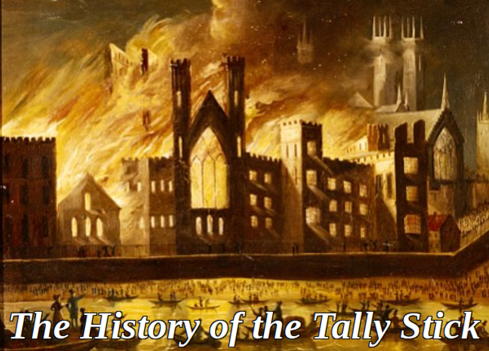Views: 473

In England, tallies took on the characteristics of today’s credit card system, as lenders carved out the details of the loan using a system of notches, to signify denominations on the surface of a small squared willow, pine, or hazel- wood stick.
At the top of the tally, a cut the thickness of the palm of a man’s hand was made, representing one thousand pounds, then subsequent cuts were made to designate other values. The breadth of a thumb meant one hundred pounds, the width of a little finger represented twenty pounds, the width of a barleycorn translated to one pound, and so on. The stick was then split in half lengthwise through the centre of the carving, creating a “split tally,” which prevented either user from adding notches to his half of the tally stick. (this is the same concept used with a true medium of exchange (TME), each suspended trade TME is examined before it can be traded, to determine if it has attached guarantees, and a connected origin, to see if they tally, then the blockchain of transfer of that specific suspended trade TME is examined to determine if it belongs to the traders account. See: A True Medium of Exchange
Each party to the transaction was given one half of the marked tally as proof. Because the type of wood used to create the tally was selected for its clear grain, the grain of the wood when halved would be perfectly matched, fraud was impossible to perpetrate, and refinements were added over time to make the documentation of the transaction virtually tamper-proof.
The two halves of the stick were made different lengths, with the Lender given the longer part of the stick, referred to as the stock, which formed the basis for the modern term “stockholder” while the shorter portion, called the foil, was given to the party who had received the goods or funds. Literally, the debtor received “the short end of the stick.”
When the borrower returned to the lender with the goods or money owed, the two halves of the record would be “tallied,” and any attempts at fraud would become immediately apparent when the two halves of the split tally were combined.
The earliest known tally stick is the ‘Ishango Bone tally’ made from the thigh-bone of a baboon, and dates from around 18000-20000 BC (Upper Palaeolithic). Historical reference is made by Pliny the Elder (AD 23–79) about the best wood to use for tallies, and by Marco Polo (1254–1324) who mentions the use of the tally in China.
The Crown Corporation government Mafia first began using the tally stick around 1100, with a preference for hazel wood sticks that for several centuries served as Exchequer accounting records, detailing payments of taxes made to the Royal Treasury by the Sovereign’s tax collectors. Their use was ended in 1827 as a method of debt and credit management, that role was, from 1694, taken over by the private Corporation, the Bank of England.
In 1688, as a result of the foreign invasion and the imposing of the homosexual banker William of Orange from the Netherlands as the new Monarch, the City of London, in preparation for the establishment of the central banking model, became a fully independent and autonomous State, outside the United Kingdom, and later was also outside the E.U when the U.K was a member. The City of London is widely referred to simply as the City (differentiated from the phrase “the city of London” by capitalising City) and known as the Square Mile, which comprises 1.12 sq mi (716.80 acres; 2.90 km2) in area.
The Bank of England was privately owned when created in 1694, a third by the Monarchy of England, a third by the Vatican and a third by the Rothschild family from 1815, after the Rothschild’s defrauded the Lords of England out of their collective shares.
The Bank of England‘s headquarters are within the City State of London, on Threadneedle Street, since 1734, which means the finances of the UK are conducted outside the UK PLC’s jurisdiction, by a foreign power. This central banking Mafia model was the blueprint on which most modern central banks have been based.
When the actions of the owners of the Bank of England became so outrageous in the thefts and frauds they perpetrated, the banks owners masked their frauds by making the bank publicly owned, nationalised in 1946, this changed the process of theft into a bonding system, the original owners then simply issued interest bearing bonds, created from nothing, allowing the bank to print or digitally generate new money, lent to the government corporation (U.K. PLC – a Public Limited Company exists as a separate entity to the owners, offering protection from liabilities and debt), that the tax payer (farmed population) was required to pay back with interest.
The Bank of England became an independent public organisation in 1998, wholly “owned” by the Treasury Solicitor on behalf of the UK PLC. The position of the Treasury Solicitor was established in 1696.
In 1834 the “stockpile” of now defunct wooden tallies were used to burn down the houses of parliament, a medieval building-complex, claimed burnt down accidentally, but, much like the great fire of London of 1666, more likely a planned demolition, to make way for the new structure, with the new parliament built between 1840–1876 named the Palace of Westminster.



